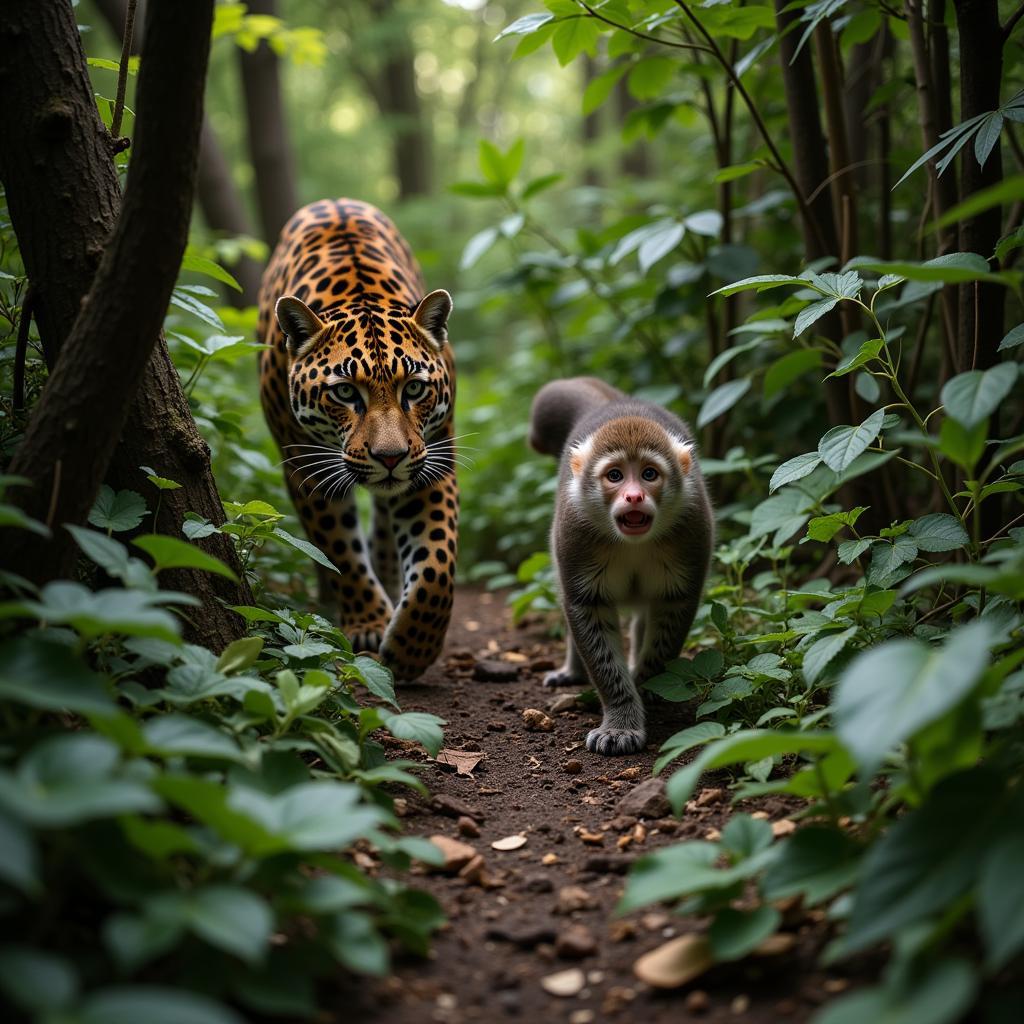The food chain of a monkey offers a fascinating glimpse into the complex web of life within various ecosystems, particularly tropical rainforests. From the fruits and leaves they consume to the predators that hunt them, monkeys play a vital role in maintaining the delicate balance of their environment. Let’s delve deeper into this intricate world and discover the fascinating dynamics of the monkey’s place in the food chain.
What Does a Monkey Eat? A Deep Dive into Their Diet
Monkeys, being primarily herbivores, enjoy a diverse diet consisting mainly of fruits, leaves, flowers, nuts, and seeds. However, some species also incorporate insects, eggs, and small animals into their diet, showcasing their adaptability and opportunistic feeding habits. This varied diet makes them important seed dispersers and contributes significantly to the health of the forest ecosystem. For instance, howler monkeys, known for their loud calls, primarily feed on leaves, while spider monkeys prefer ripe fruits. This dietary specialization helps prevent excessive competition for resources within the rainforest. Check out our key food ad for more information about the importance of a balanced diet.
The Role of Fruits and Leaves in a Monkey’s Diet
Fruits provide monkeys with essential sugars and vitamins, giving them the energy they need for their active lifestyles. Leaves, on the other hand, offer a good source of fiber and other nutrients. This balance of energy and nutrients is crucial for their survival.
Predators of Monkeys: Navigating the Dangers of the Jungle
While monkeys are agile and intelligent creatures, they are not without their predators. Large cats like jaguars and leopards, along with birds of prey like eagles and hawks, pose a significant threat to monkeys.  Jaguar Hunting Monkey in Forest Even snakes, particularly large constrictors, can prey on smaller monkey species. This constant threat from predators influences monkey behavior, leading them to develop sophisticated alarm calls and evasive maneuvers.
Jaguar Hunting Monkey in Forest Even snakes, particularly large constrictors, can prey on smaller monkey species. This constant threat from predators influences monkey behavior, leading them to develop sophisticated alarm calls and evasive maneuvers.
How Monkeys Protect Themselves from Predators
Monkeys have evolved various defense mechanisms to protect themselves. Living in troops provides strength in numbers, allowing them to collectively spot predators and warn each other of danger. Their agility and ability to climb trees also give them an advantage in escaping predators.
The Monkey’s Place in the Rainforest Food Web
Monkeys occupy a crucial middle rung in the rainforest food web. They consume plants and insects, while also serving as prey for larger animals. This intricate network of interconnected food chains forms the rain forest ecosystem food web, a complex and dynamic system where each species plays a vital role. The removal of monkeys from this ecosystem would have cascading effects, impacting both the plant life they consume and the predators that rely on them for sustenance. For a more detailed understanding of the rainforest biome and its food web, you can explore our food web tropical rainforest biome resource.
“Understanding the food chain of a monkey is essential for comprehending the complex dynamics of rainforest ecosystems,” says Dr. Jane Goodall, a renowned primatologist. “Their role as both predator and prey highlights the interconnectedness of life within these vital habitats.”
Conclusion: The Importance of Understanding the Food Chain of a Monkey
The food chain of a monkey provides valuable insights into the delicate balance of nature within rainforest ecosystems. From their diverse diet to their role as both predator and prey, monkeys play a crucial part in maintaining the health and stability of these vital environments. Learning more about their place in the tropical forest biome food web helps us appreciate the interconnectedness of life and the importance of conservation efforts.
FAQ
- What is the main food source for monkeys? Primarily fruits, leaves, nuts, and seeds.
- What animals prey on monkeys? Jaguars, leopards, eagles, hawks, and large snakes.
- How do monkeys contribute to the rainforest ecosystem? They disperse seeds and control insect populations.
- What would happen if monkeys were removed from the rainforest? The ecosystem would be significantly disrupted, impacting both plants and other animals.
- Where can I find a visual representation of a food chain? Consider exploring our food chain coloring sheet.
For further assistance, please contact us at Phone Number: 02437655121, Email: minacones@gmail.com or visit our address: 3PGH+8R9, ĐT70A, thôn Trung, Bắc Từ Liêm, Hà Nội, Việt Nam. We have a 24/7 customer service team ready to help.